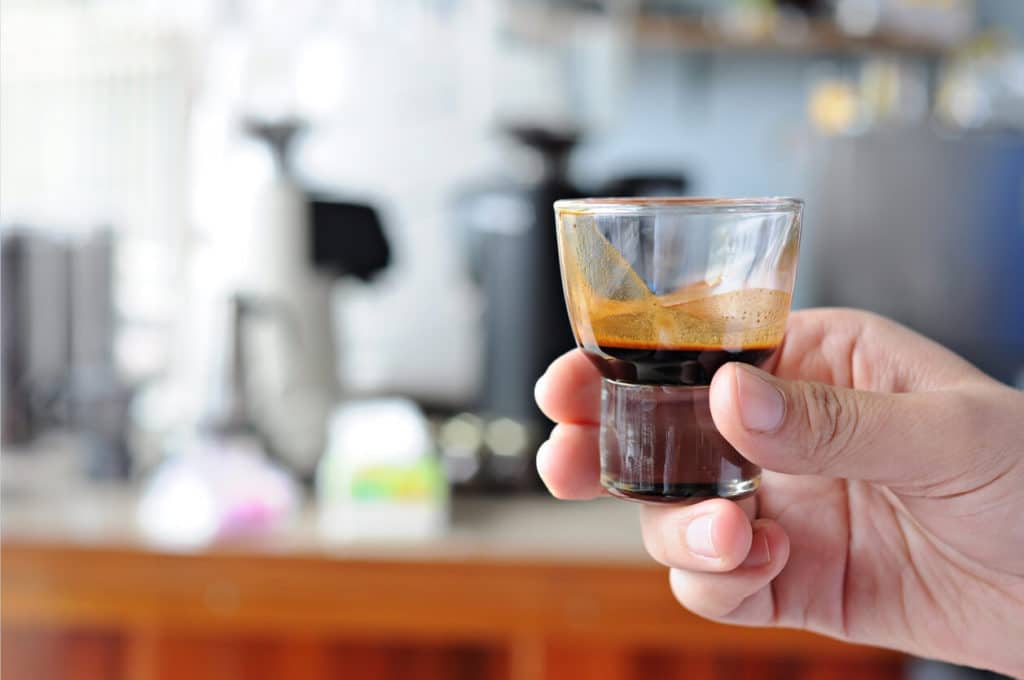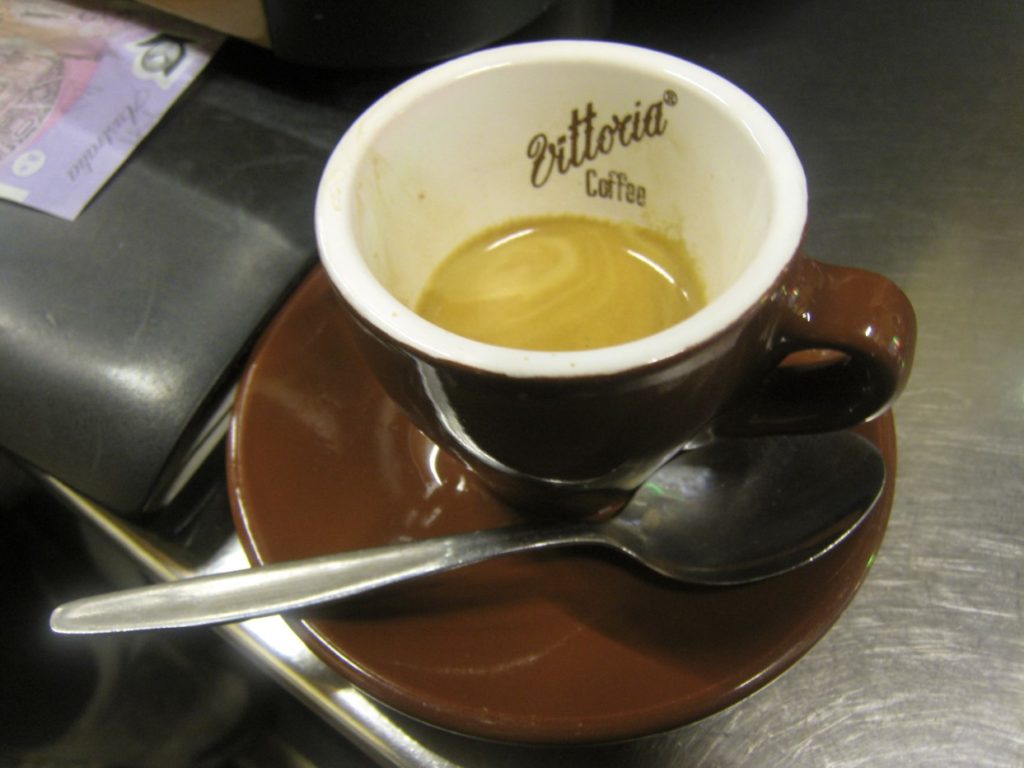Ristretto vs Long Shot (and Other Espresso Types)

Well, you're probably wondering what the heck is all this coffee gibberish and why can't coffee just be coffee.
But you also have a curious mind and you just want to know what are the main differences between a Ristretto vs Long Shot.
This is why you are here and you chose the right place to learn about these two espresso drinks!
So let’s get started...
What Are The Key Differences Between a Ristretto and a Long Shot?
The main differences between a Ristretto and a Long Shot are that a Ristretto uses less water and has a shorter extraction time than a Long Shot.
A Ristretto is usually made with one part coffee to one part water and is extracted for around 15 seconds. A Long Shot is usually made with one part coffee to three parts water and is extracted for around 40 seconds.
Less water and lower extraction times mean that Ristrettos have a fuller body and fruiter flavor profile than a Long Shot, which is smoother and a touch more bitter in comparison.
Ristretto vs Long Shot: A Difference in Brew Ratio
Now let’s dive into a bit more detail.
Ristretto and Long Shots (also known as “lungos” - Italian for long) are characterized by their brew ratio.
Brew ratio refers to the proportion of ground coffee that you use when making an espresso (the dose) compared to the amount of liquid coffee that ends up in your cup (the yield).
For example, if you make one ounce of liquid coffee, and you want a dose to yield ratio of 1:1 to make a Ristretto, you would want to use one ounce of ground coffee as your dose for this.
That same ounce of ground coffee could also make a three-ounce Long Shot, as this drink has a brew ratio of 1:3.
It's worth noting here that measuring both the dose and the yield should be done in weight measurement rather than in volumetric measurements.
This is intentional as if we were to measure our yield in terms of volume, we would get inconsistent results depending on the amount of crema that the specific coffee shot produced. Plus, different coffee beans might not necessarily weigh the same given the same volume.
Measuring yield in weight keeps things consistent.
This means that if you want to measure the brew ratio accurately, you will need to keep your espresso cup on a scale while your espresso machine pulls the shot, so you can measure your yield by weight.
Ristretto vs Long Shot: A Difference in Extraction
Extraction refers to the amount of time that water is in direct contact with ground coffee during brewing.
As Long Shots have a greater volume of water flowing through the ground coffee, they have a longer extraction time than a Ristretto.
With a Ristretto you want an extraction time of around 12-18 seconds.
Long Shots should have an extraction time of 40-50 seconds.
Grind Size and Extraction Times
Things are a bit more nuanced when it comes to extraction times though.
Extraction times are not purely based on the amount of water that you pass through your coffee grounds when brewing.
Grind size also plays a big role in extraction times.
When coffee grinds are packed together in a dose, the finer the coffee ground is, the less space there will be between each individual grind.
Water will therefore flow more slowly through more finely ground coffee than through more coarsely ground coffee.

To make Ristretto and Long Shots with the correct extraction time you need to experiment with different grind sizes until you can match up the correct brew ratio with the correct extraction time.
If the correct brew ratio leads to too short an extraction time, then use a finer grind or vice versa.
How Does Ristretto and a Long Shot Compare in Flavor?
Ristretto has a fuller body and a sweeter, sharper taste than Long Shots.
Long Shots, in comparison, have a bitter woody flavor and little body by espresso’s standards. Due to the additional water used in a Long Shot, its texture is somewhere between an espresso and a filter coffee.
The flavor profile of Ristrettos and Long Shots are products of their differing brew ratio and extraction times.
How Brew Ratio Affects the Taste of Coffee
Brew ratio affects the body of a coffee, with a higher dose-to-yield ratio creating a fuller-bodied coffee.
This is because the oils on the outer layer of ground coffee are what give coffee its body. These are the first compounds in coffee to be extracted into water when it percolates through it.
Therefore the more coffee that you have come into contact with water, the more full-bodied a coffee you will create.
How Extraction Time Affects the Taste of Coffee
Extraction times affect the flavor of the coffee. Lower extraction times tend to create sharper tasting coffee, with higher extraction times creating more bitter coffee.
Long Shot’s additional bitterness compared to the sharper tasting Ristretto can be attributed to its longer extraction times.
Coffees that have been extracted quickly (under-extracted) have a sharp taste because the acids in the ground coffee haven't had enough contact time with water to be fully broken down.
Coffees with longer extraction times are more bitter because the compounds that create this bitter flavor are less soluble than the oils and acids in ground coffee. Therefore more contact time with water is needed for them to end up in your cup.
How do Ristretto and Long Shots Compare to Other Espresso Drinks?
Traditional espresso shots are meant to be brewed under nine bars of pressure and at a temperature of 190 degrees Fahrenheit as per the Istituto Espresso Italiano.
What separates the different types of coffee shots is, again, their brew ratio and their extraction time.
We’ve prepared this handy table to show the brew ratios and extraction times for the different types of coffee shots:
| Type of Espresso Drink | Brew ratio | Extraction time |
| Ristretto | 1:1 | 12-18 seconds |
| Espresso | 1:2 | 25-30 seconds |
| Long Shot | 1:3 | 40-50 seconds |
What is the Difference Between a Long Shot and a Double Espresso?
Since a Long Shot espresso and a double espresso often contain the same volume of liquid, people tend to confuse the two drinks.
A double espresso is simply an espresso that uses double the amount of coffee and double the amount of water.
A double espresso’s brew ratio is, therefore, the same as a single espresso because both the coffee and water amounts are doubled up.
A Long Shot, on the other hand, contains around 50% more water (by weight) than a single espresso while containing the same amount of brew.
A Long Shot, therefore, has a lower brew ratio than a double shot of espresso.
What is the Difference Between a Long Shot and an Americano?
Both Long Shots and Americano are “espresso based drinks” that contain more water than a single espresso. This can cause some confusion about how the two drinks are made.
The key difference between a Long Shot and an Americano is that with a Long Shot all the water in the drink is brewed directly with the ground coffee.
Americano on the other hand is just an espresso shot with hot water added to it after brewing.
Typically an Americano is a taller drink than a Long Shot, but this does not have to be the case.
What Drinks are Ristretto and Long Shots Used In?
As Long Shots and ristretto shots are not prepared as frequently as Single or Double Espressos, the latter shots are far more likely to be used in milk-based espresso drinks like lattes, Cappuccino, and Flat Whites.
Starbucks coffee shops use a double Ristretto shot (rather than Espresso shots) in their Cortado.

Although they do not specifically say why they use Ristretto rather than Espresso, it might be down to the fact that their Cortado is only 6oz, the smaller Ristretto makes it easier to put enough milk in this drink.
Frequently Asked Questions
Is Ristretto the strongest coffee?
Ristretto has the highest brew ratio of all coffees, and in that sense, it is the “strongest” coffee. It is not necessarily the strongest tasting, or the most heavily caffeinated coffee, however.
Which has more caffeine, a long shot or a ristretto?
A Long Shot has more caffeine than a Ristretto. This is because a Long Shot has a longer extraction time than a Ristretto. Caffeine dissolves in water relatively slowly, so caffeine content is more dictated by extraction time than by the amount of ground coffee used in a brew.
Do Italians drink ristretto or lungo?
Ristretto is commonly drunk in Italy, particularly in the North of Italy where it is often referred to as a Basso. Lungo is less commonly drunk in Italy but is more popular in North America and Australia.
Is Ristretto stronger than espresso?
Ristretto has a higher brew ratio than regular espresso, meaning that it has a fuller body and a sharper taste. I wouldn’t go as far as to say that Ristretto has a stronger flavor than espresso, they just have a different flavor. Espresso has more caffeine than Ristretto.
Can Ristretto make Lattes?
You can make a latte with a Ristretto. Just bear in mind that you might want to use a little less sugar (if you use any at all!) when making a latte with a Ristretto as these types of shots are naturally sweeter than espresso.
Can you make Ristrettos and long shots without an espresso machine?
No, to prepare these espresso drinks you will need an espresso machine. The reason is that these drinks require high-pressure brewing. If you’re one to buy espresso every day, then it might make sense to get a good value espresso machine to save money in the long run. You can also get something close to espresso with an AeroPress or a Nespresso Machine.

Bottom Line
There you have it! The key difference between a Ristretto and a Long Shot is their brew ratio and extraction times.
Ristretto and Long Shot are brewed in the same way as espresso, though the former uses less water than an espresso, the latter uses a bit more water.
This variation in the amount of water used can make a huge difference to the flavor profile of these two coffees, with Ristretto often having a more concentrated flavor and being sweet and sharp whereas a Long Shot is smooth and bitter.
This article is intended for informational purposes only. It is not meant to replace professional medical advice, treatment or diagnosis. Do not consume any type of coffee, tea or herbal infusion if you are allergic to it. The information in this article is not intended to treat serious medical conditions. Please seek professional medical advice before using home remedies.
.